A 2.6 GS/s 8-Bit Time-Interleaved SAR ADC in 55 nm CMOS Technology
Abstract
:1. Introduction
2. Proposed TI SAR ADC Architecture
3. Circuit Implementation Details
3.1. Channel-Selection-Embedded Bootstrap Switch
3.2. Sub-ADC Design
3.2.1. Asynchronous Timing of Alternate Comparators
3.2.2. The Background Offset Calibration of Comparator
3.2.3. Segmented Pre-Quantization and Bypass Switching Scheme
4. Measured Results
5. Conclusions
Author Contributions
Funding
Conflicts of Interest
References
- Lin, C.; Wei, Y.; Lee, T. A 10-bit 2.6-GS/s Time-Interleaved SAR ADC With a Digital-Mixing Timing-Skew Calibration Technique. IEEE J. Solid-State Circuits 2018, 53, 1508–1517. [Google Scholar] [CrossRef]
- Harpe, P.J.A.; Zhou, C.; Bi, Y.; van der Meijis, N.P.; Wang, X.; Philips, K.; Dolmans, G.; de groot, H. A 26µW 8 bit 10 MS/s Asynchronous SAR ADC for Low Energy Radios. IEEE J. Solid-State Circuits 2011, 46, 1585–1595. [Google Scholar] [CrossRef]
- Doris, K.; Janssen, E.; Nani, C.; Zanikopoulos, A.; van der Weide, G. A 480 mW 2.6 GS/s 10b Time-Interleaved ADC With 48.5 dB SNDR up to Nyquist in 65 nm CMOS. IEEE J. Solid-State Circuits 2011, 46, 2821–2833. [Google Scholar] [CrossRef]
- Fredenburg, J.A.; Flynn, M.P. Statistical Analysis of ENOB and Yield in Binary Weighted ADCs and DACS With Random Element Mismatch. IEEE Trans. Circuits Syst. Regul. Pap. 2012, 59, 1396–1408. [Google Scholar] [CrossRef]
- Miki, T.; Ozeki, T.; Naka, J. A 2-GS/s 8-bit Time-Interleaved SAR ADC for Millimeter-Wave Pulsed Radar Baseband SoC. IEEE J. Solid-State Circuits 2017, 52, 2712–2720. [Google Scholar] [CrossRef]
- Xu, D.-G.; Pu, J.; Xu, S.-L.; Zhang, Z.-P.; Chen, K.-R.; Chen, Y.-Y.; Zhang, J.-A.; Wang, J.-A. A 10-bit 1.2 GS/s 45 mW time-interleaved SAR ADC with background calibration. IEICE Electron. Express 2018, 15, 1–12. [Google Scholar]
- Kull, L.; Pliva, J.; Toifl, T.; Schmatz, M.; Francese, P.A.; Menolfi, C.; Brandli, M.; Kossel, M.; Morf, B.; Andersen, T.M.; et al. Implementation of Low-Power 6–8 b 30–90 GS/s Time-Interleaved ADCs With Optimized Input Bandwidth in 32 nm CMOS. IEEE J. Solid-State Circuits 2016, 51, 636–648. [Google Scholar] [CrossRef]
- Stepanovic, D.; Nikolic, B. A 2.8 GS/s 44.6 mW Time-Interleaved ADC Achieving 50.9 dB SNDR and 3 dB Effective Resolution Bandwidth of 1.5 GHz in 65 nm CMOS. IEEE J. Solid-State Circuits 2013, 48, 971–982. [Google Scholar] [CrossRef] [Green Version]
- Lee, S.; Chandrakasan, A.P.; Lee, H. A 1 GS/s 10b 18.9 mW Time-Interleaved SAR ADC With Background Timing Skew Calibration. IEEE J. Solid-State Circuits 2014, 49, 2846–2856. [Google Scholar] [CrossRef]
- Lee, H.; Aurangozeb; Park, S.; Kim, J. A 6-bit 2.5-GS/s Time-Interleaved Analog-to-Digital Converter Using Resistor-Array Sharing Digital-to-Analog Converter. IEEE Trans. Very Large Scale Integr. VLSI Syst. 2015, 23, 2371–2383. [Google Scholar] [CrossRef]
- Wei, H.; Zhang, P.; Sahoo, B.D.; Razavi, B. An 8 Bit 4 GS/s 120 mW CMOS ADC. IEEE J. Solid-State Circuits 2014, 49, 1751–1761. [Google Scholar] [CrossRef]
- Zhu, Y.; Chan, C.-H.; Zheng, Z.-H.; Li, C.; Zhong, J.-Y.; Martins, R.P. A 0.19 mm2 10 b 2.3 GS/s 12-Way Time-Interleaved Pipelined-SAR ADC in 65-nm CMOS. IEEE Trans. Circuits Syst. Regul. Pap. 2018, 65, 3606–3616. [Google Scholar] [CrossRef]
- Janssen, E.; Doris, K.; Zanikopoulos, A.; Murroni, A.; van der Weide, G.; Lin, Y.; Alvado, L.; Darthenay, F.; Fregeais, Y. An 11b 3.6 GS/s time-interleaved SAR ADC in 65nm CMOS. In Proceedings of the 2013 IEEE International Solid-State Circuits Conference Digest of Technical Papers, San Francisco, CA, USA, 17–21 February 2013; pp. 464–465. [Google Scholar]
- Kundu, S.; Alpman, E.; Lu, H.-L.; Lakdawala, H.; Paramesh, J.; Jung, B.; Zur, S.; Gordon, E. A 1.2 V 2.64 GS/s 8 bit 39 mW Skew-Tolerant Time-interleaved SAR ADC in 40 nm Digital LP CMOS for 60 GHz WLAN. IEEE Trans. Circuits Syst. Regul. Pap. 2015, 62, 1929–1939. [Google Scholar] [CrossRef]
- Lien, Y.-C. A 14.6 mW 12b 800 MS/s 4×time-interleaved pipelined SAR ADC achieving 60.8 dB SNDR with Nyquist input and sampling timing skew of 60fsrms without calibration. In Proceedings of the 2016 IEEE Symposium on VLSI Circuits (VLSI-Circuits), Honolulu, HI, USA, 15–17 June 2016; pp. 1–2. [Google Scholar]
- Zhu, Y.; Chan, C.-H.; U, S.-P.; Martins, R.P. An 11b 900 MS/s time-interleaved sub-ranging pipelined-SAR ADC. In Proceedings of the ESSCIRC 2014—40th European Solid State Circuits Conference (ESSCIRC), Venice Lido, Italy, 22–26 September 2014. [Google Scholar] [CrossRef]
- Zhu, X.; Zhou, L.; Wu, D.; Wu, J.; Liu, X. A 6 mW 325 MS/s 8 bit SAR ADC with background offset calibration. IEICE Electron. Express 2017, 14, 1–8. [Google Scholar] [CrossRef]
- Kuo, B.-Y.; Chen, B.-W.; Tsai, C.-M. A 0.6 V, 1.3 GHz dynamic comparator with cross-coupled latches. In Proceedings of the VLSI Design, Automation and Test (VLSI-DAT), Hsinchu, Taiwan, 27–29 April 2015; pp. 1–4. [Google Scholar]
- Fang, J.; Thirunakkarasu, S.; Yu, X.; Silva-Rivas, F.; Zhang, C.; Singor, F.; Abraham, J. A 5-GS/s 10-b 76-mW Time-Interleaved SAR ADC in 28 nm CMOS. IEEE Trans. Circuits Syst. Regul. Pap. 2017, 64, 1673–1683. [Google Scholar] [CrossRef]
- Kull, L.; Toifl, T.; Schmatz, M.; Francese, P.A.; Menolfi, C.; Brandli, M.; Kossel, M.; Morf, T.; Andersen, T.M.; Leblebici, Y. A 3.1 mW 8b 1.2 GS/s Single-Channel Asynchronous SAR ADC With Alternate Comparators for Enhanced Speed in 32 nm Digital SOI CMOS. IEEE J. Solid-State Circuits 2013, 48, 3049–3058. [Google Scholar] [CrossRef]
- Chen, S.M.; Brodersen, R.W. A 6-bit 600-MS/s 5.3-mW Asynchronous ADC in 0.13-μm CMOS. IEEE J. Solid-State Circuits 2006, 41, 2669–2680. [Google Scholar] [CrossRef]
- Liu, C.-C.; Chang, S.-J.; Huang, G.-Y.; Lin, Y.Z. A 10-bit 50-MS/s SAR ADC With a Monotonic Capacitor Switching Procedure. IEEE J. Solid-State Circuits 2010, 45, 731–740. [Google Scholar] [CrossRef]
- Liu, C.-C.; Chang, S.-J.; Huang, G.Y.; Lin, Y.-Z.; Huang, C.-M. A 1V 11fJ/conversion-step 10bit 10MS/s asynchronous SAR ADC in 0.18µm CMOS. In Proceedings of the 2010 Symposium on VLSI Circuits, Honolulu, HI, USA, 15–18 June 2010; pp. 241–242. [Google Scholar]
- Santhanalakshmi, M.; Yasoda, K. Verilog-A implementation of energy-efficient SAR ADCs for biomedical application. In Proceedings of the 2015 19th International Symposium on VLSI Design and Test, Ahmedabad, India, 26–29 June 2015; pp. 1–6. [Google Scholar]
- Huang, G.-Y.; Chang, S.-J.; Liu, C.-C.; Lin, Y.-Z. A 1-µW 10-bit 200-kS/s SAR ADC With a Bypass Window for Biomedical Applications. IEEE J. Solid-State Circuits 2012, 47, 2783–2795. [Google Scholar] [CrossRef]
- Liu, Y.; Yuan, C.; Hung, Y.L.Y. A capacitor constructed bypass window switching scheme for energy-efficient SAR ADC. In Proceedings of the 2014 IEEE International Symposium on Circuits and Systems (ISCAS), Melbourne, VIC, Australia, 15–18 June 2014; pp. 1352–1355. [Google Scholar]
- Wang, T.-Y.; Li, H.-Y.; Ma, Z.-Y.; Huang, Y.-J.; Peng, S.-Y. A Bypass-Switching SAR ADC With a Dynamic Proximity Comparator for Biomedical Applications. IEEE J. Solid-State Circuits 2018, 53, 1743–1754. [Google Scholar] [CrossRef]
- Wang, X.; Zhou, X.; Li, Q. A High-Speed Energy-Efficient Segmented Prequantize and Bypass DAC for SAR ADCs. IEEE Trans. Circuits Syst. Express Briefs 2015, 62, 756–760. [Google Scholar] [CrossRef]
- Abusleme, A.; Dragone, A.; Haller, G.; Murmann, B. Mismatch of lateral field metal-oxide-metal capacitors in 180 nm CMOS process. Electron. Letters 2012, 48, 286–287. [Google Scholar] [CrossRef]
- Zhu, Y.; Chan, C.-H.; U, S.-P.; Martins, R.P. An 11b 450 MS/s Three-Way Time-Interleaved Subranging Pipelined-SAR ADC in 65 nm CMOS. IEEE J. Solid-State Circuits 2016, 51, 1223–1234. [Google Scholar] [CrossRef]
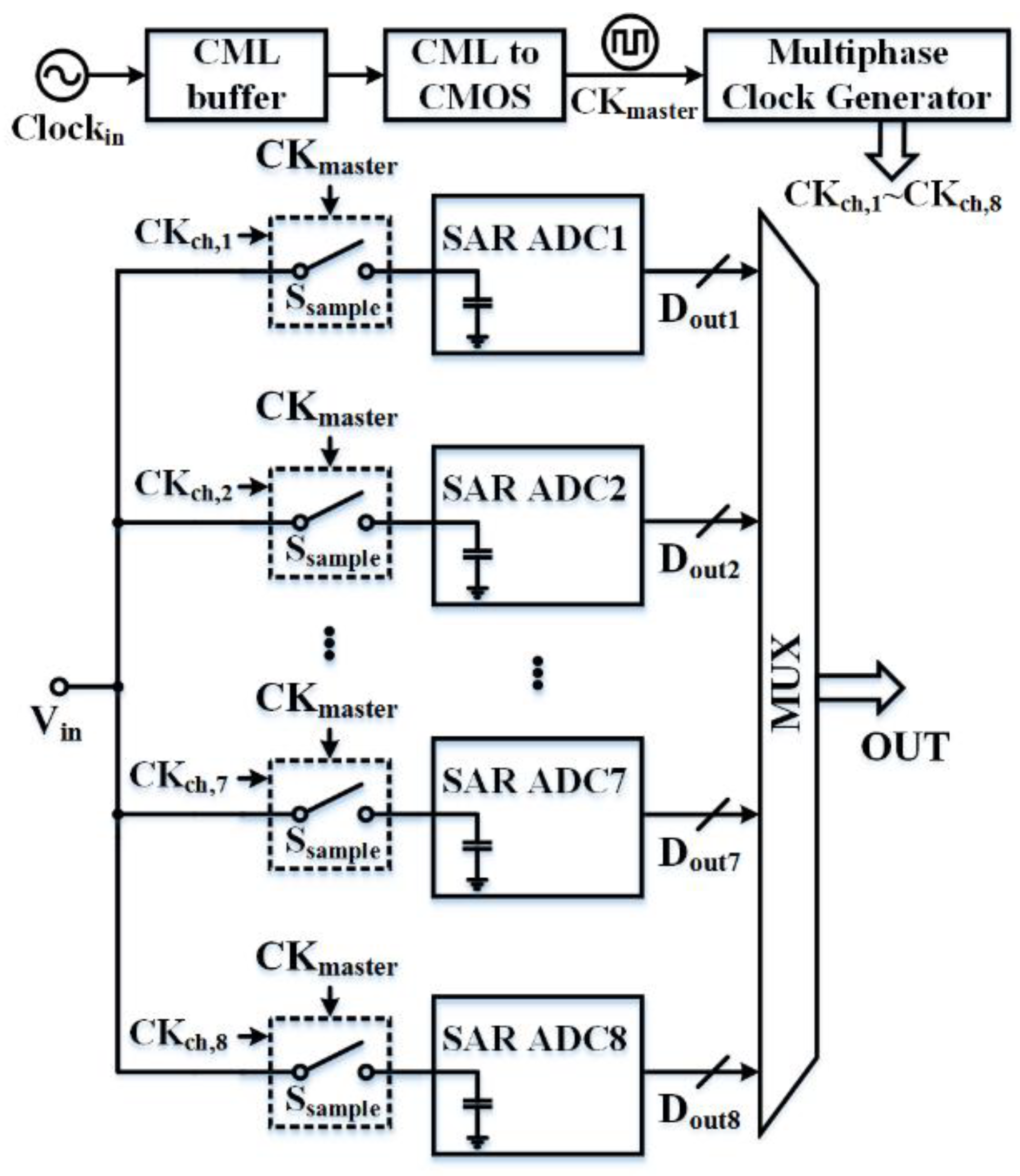

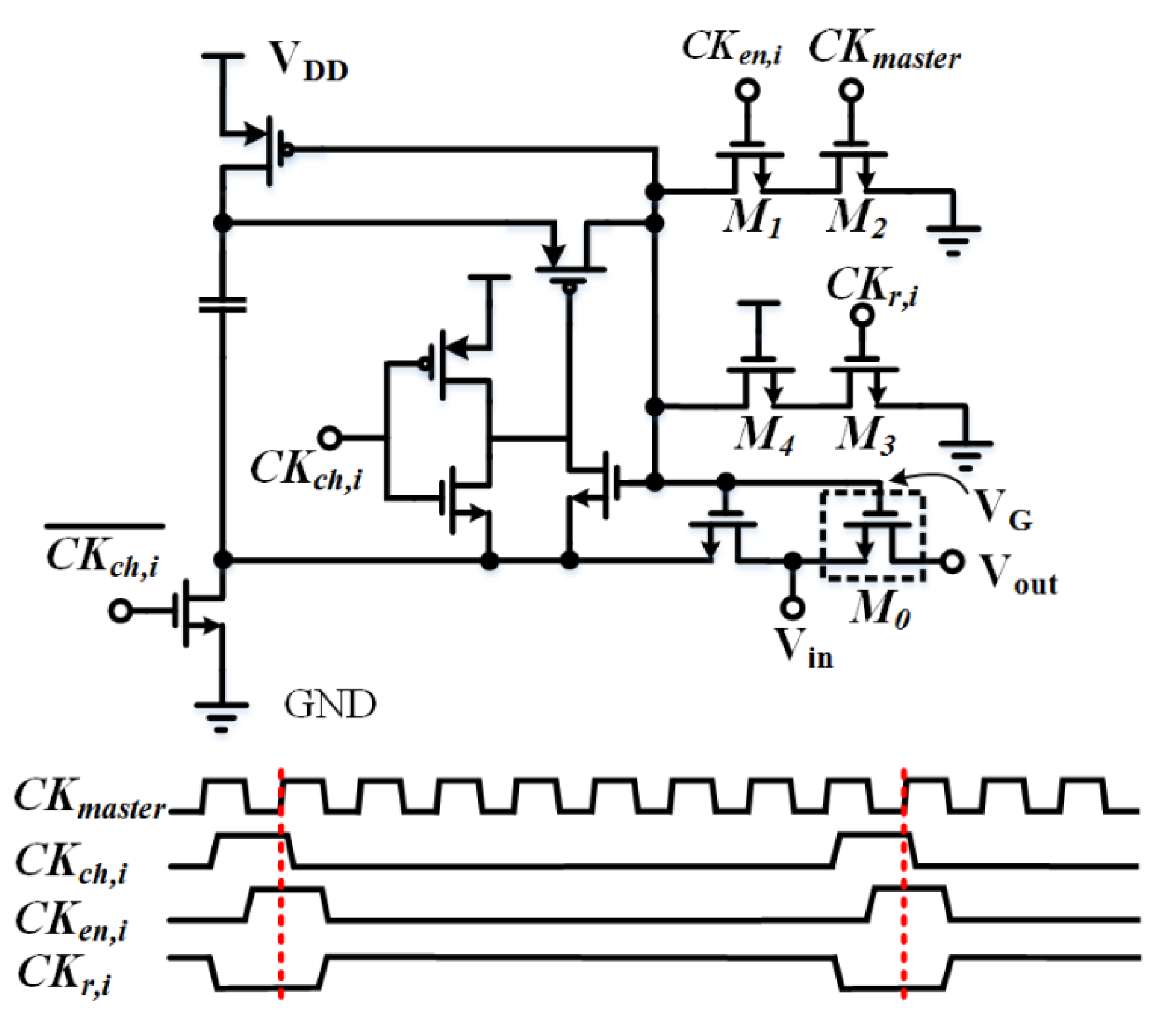
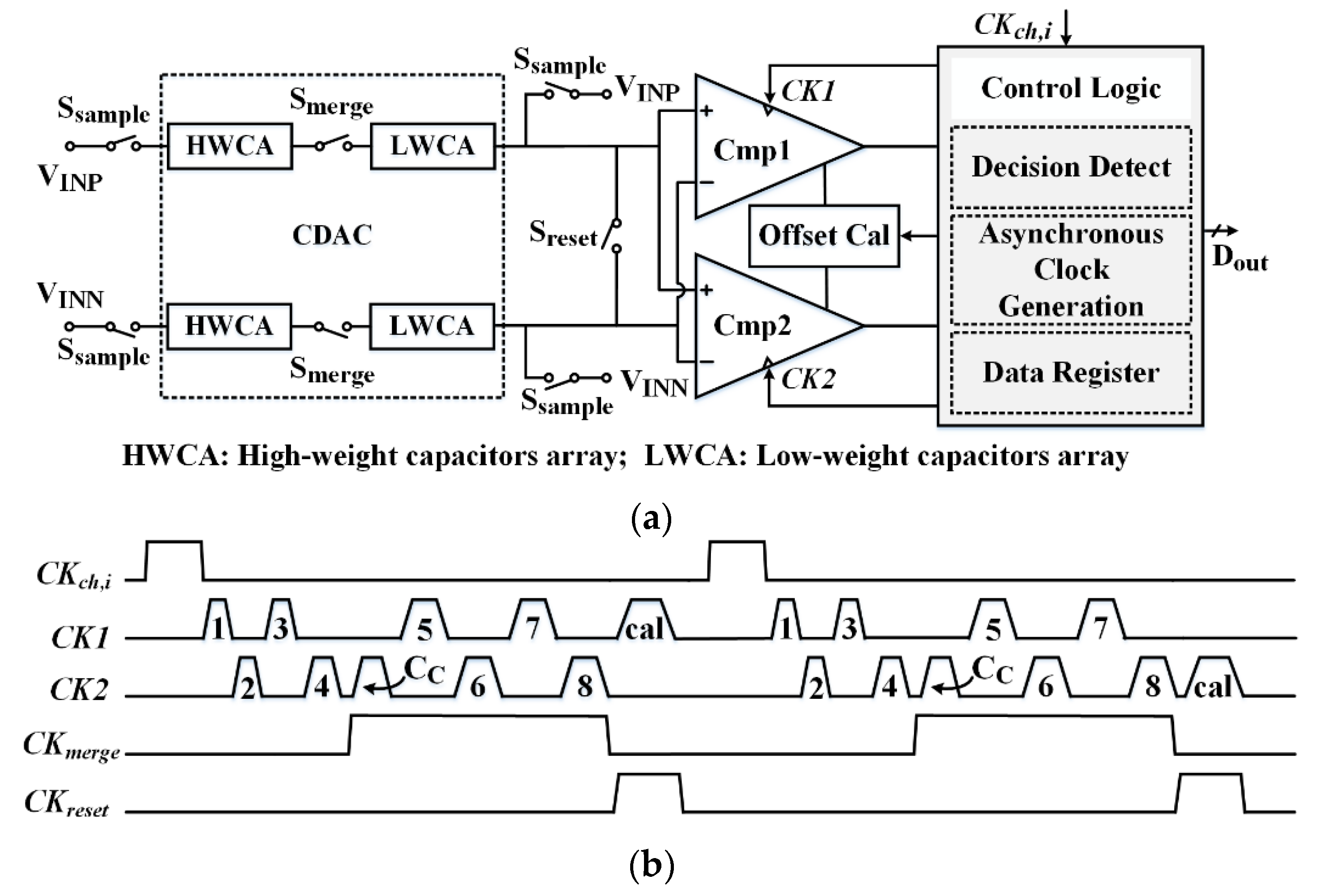
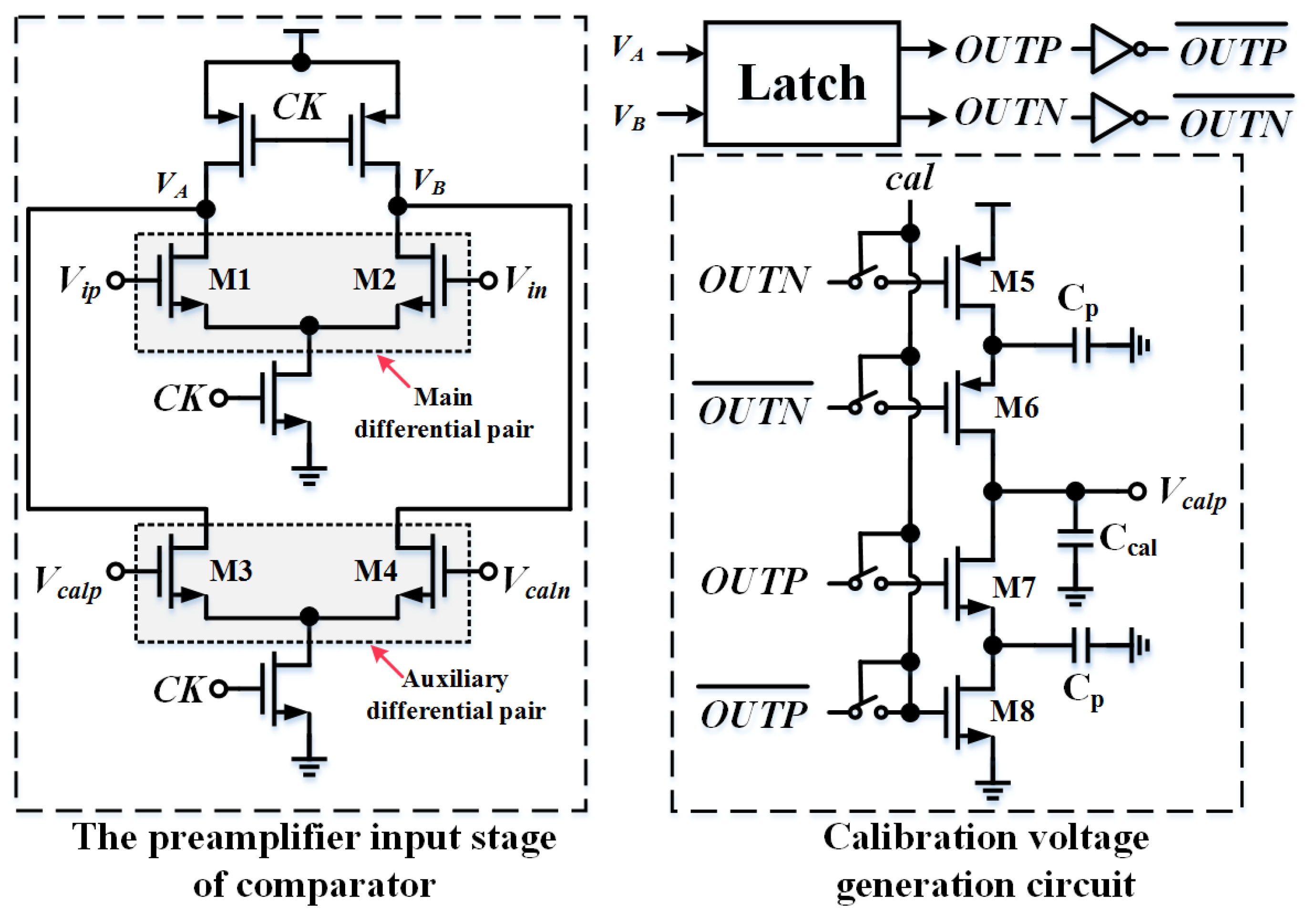
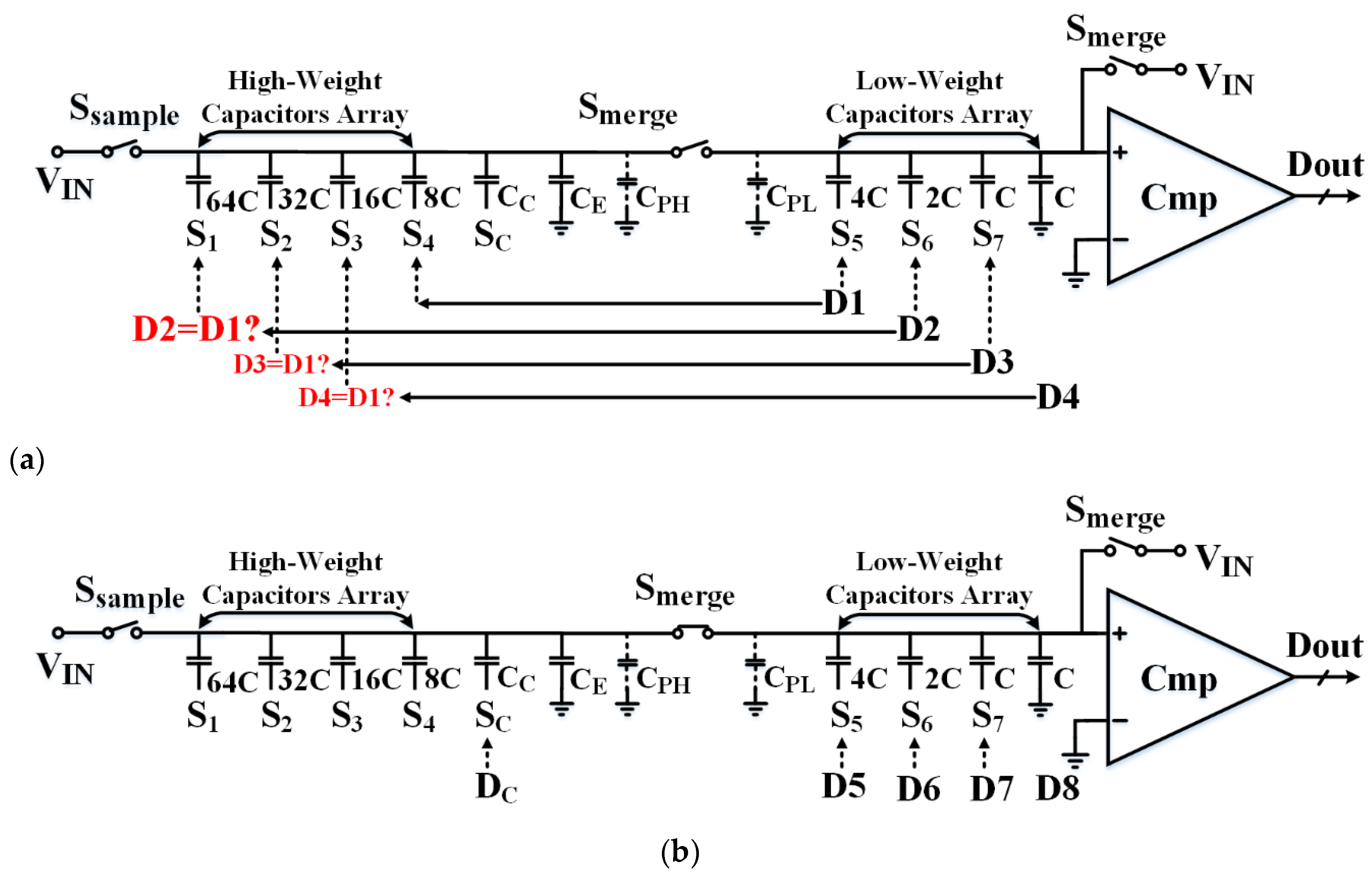
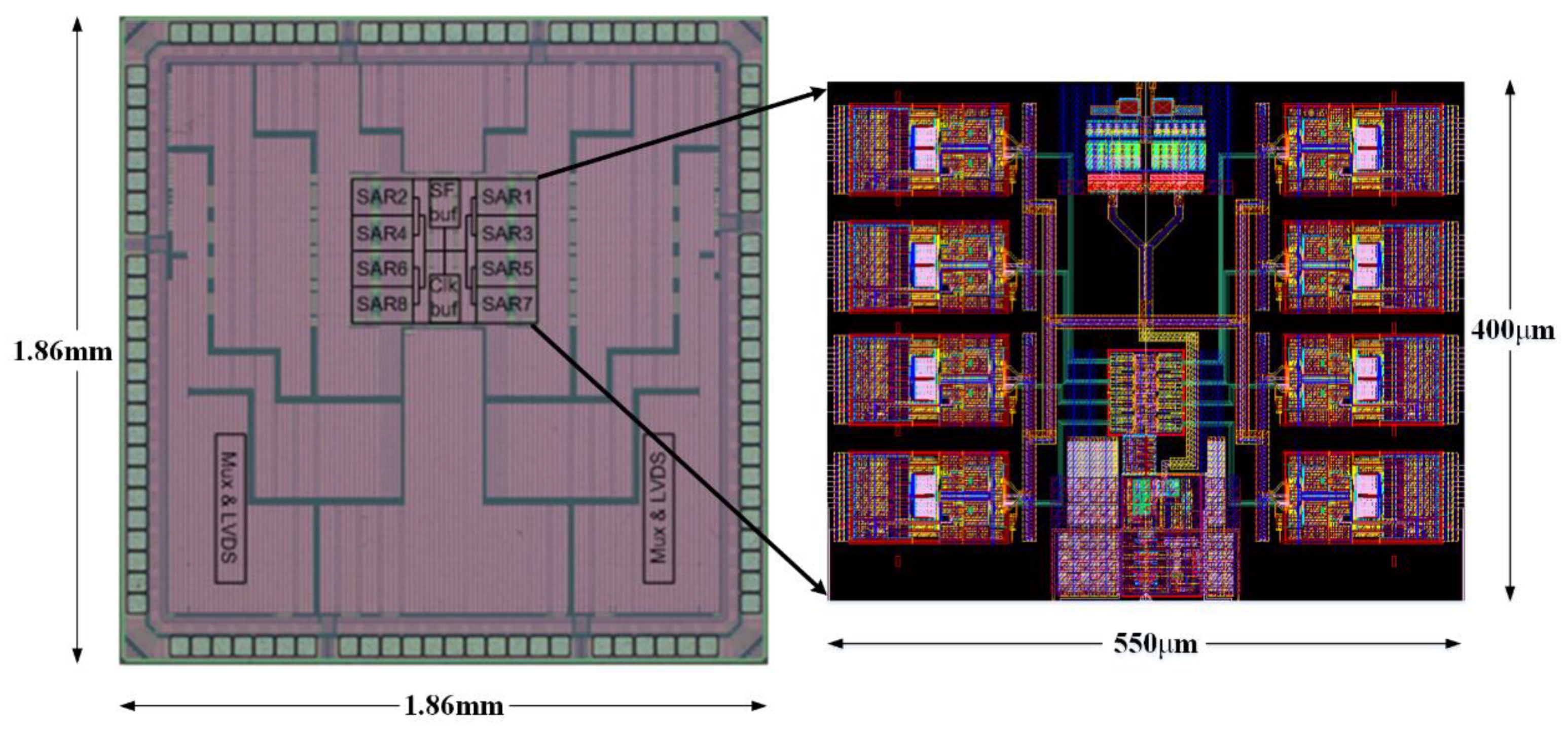
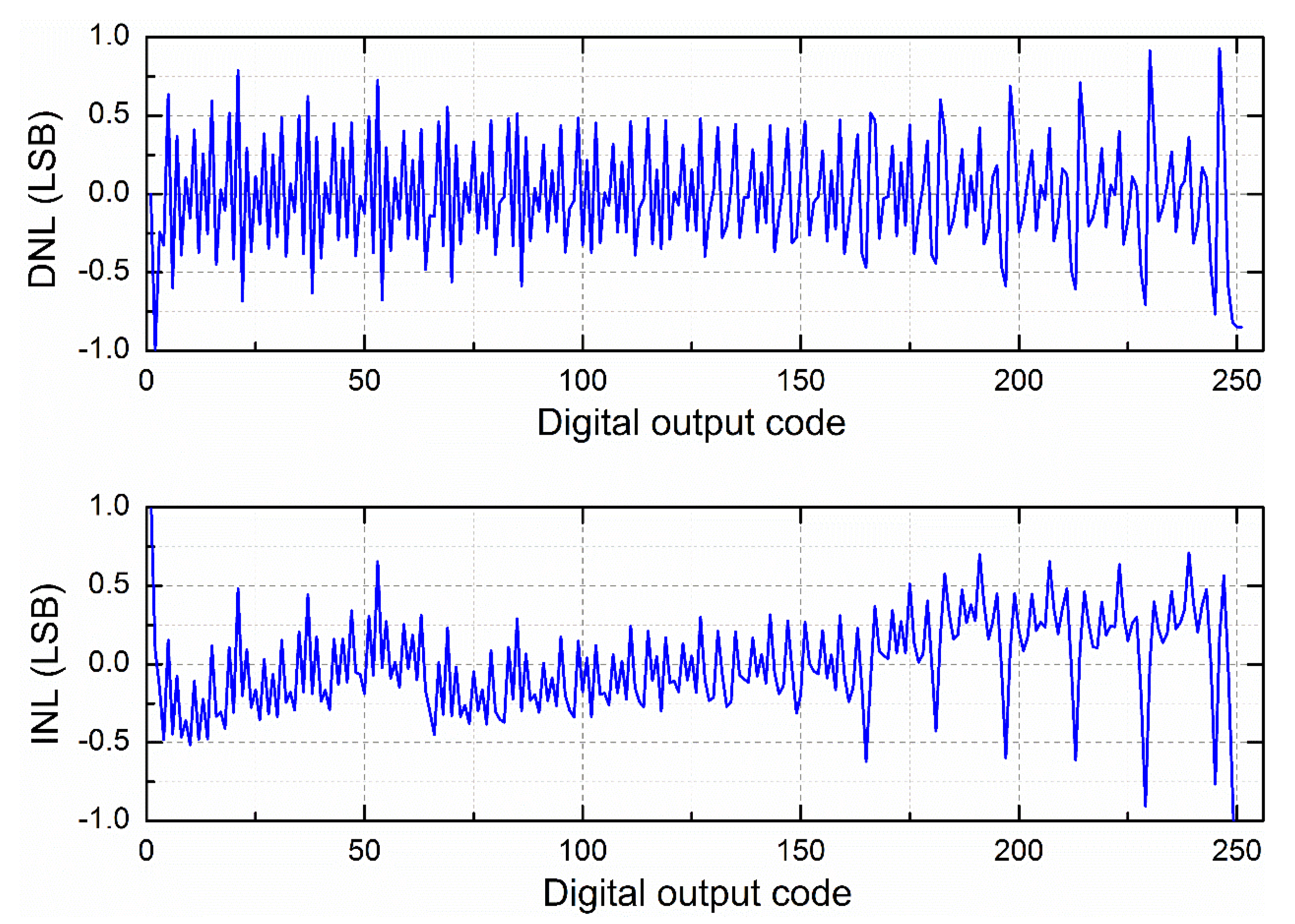


| Technology | 55-nm 1P9M CMOS |
|---|---|
| Architecture | 8-channel TI SAR |
| Sampling Rate | 2.6 GS/s |
| Resolution | 8-bit |
| Power | 60 mW |
| Active Area | 0.22 mm2 |
| DNL | +0.93/−0.85 LSB |
| INL | +0.71/−0.91 LSB |
| SFDR | ≥50.94 dB (up to115 MHz) |
| ≥47.9 dB (up to 500 MHz) | |
| ≥40.3 dB (up to Nyquist) | |
| SNDR | ≥40.54 dB (up to115 MHz) |
| ≥38.2 dB (up to 500 MHz) | |
| ≥31.8 dB (up to Nyquist) | |
| FoM 1 | 348 fJ/conversion-step |
| Calibration Complexity | On-chip offset calibration only |
© 2019 by the authors. Licensee MDPI, Basel, Switzerland. This article is an open access article distributed under the terms and conditions of the Creative Commons Attribution (CC BY) license (http://creativecommons.org/licenses/by/4.0/).
Share and Cite
Wang, D.; Zhu, X.; Guo, X.; Luan, J.; Zhou, L.; Wu, D.; Liu, H.; Wu, J.; Liu, X. A 2.6 GS/s 8-Bit Time-Interleaved SAR ADC in 55 nm CMOS Technology. Electronics 2019, 8, 305. https://doi.org/10.3390/electronics8030305
Wang D, Zhu X, Guo X, Luan J, Zhou L, Wu D, Liu H, Wu J, Liu X. A 2.6 GS/s 8-Bit Time-Interleaved SAR ADC in 55 nm CMOS Technology. Electronics. 2019; 8(3):305. https://doi.org/10.3390/electronics8030305
Chicago/Turabian StyleWang, Dong, Xiaoge Zhu, Xuan Guo, Jian Luan, Lei Zhou, Danyu Wu, Huasen Liu, Jin Wu, and Xinyu Liu. 2019. "A 2.6 GS/s 8-Bit Time-Interleaved SAR ADC in 55 nm CMOS Technology" Electronics 8, no. 3: 305. https://doi.org/10.3390/electronics8030305





